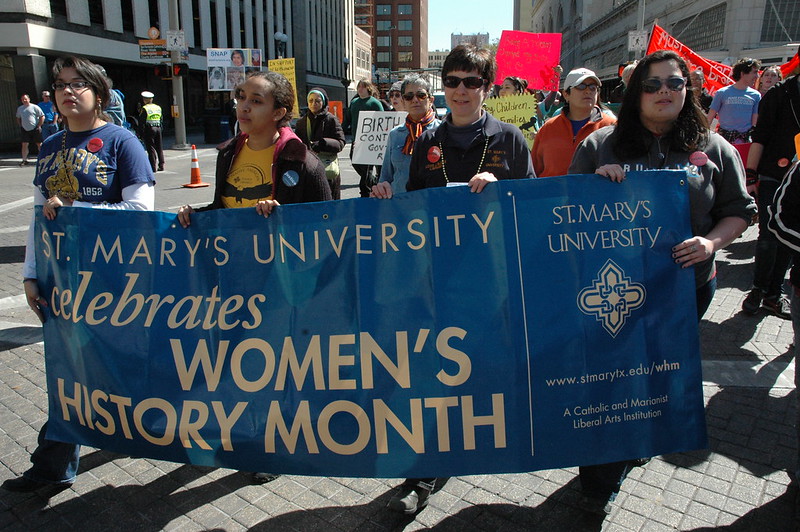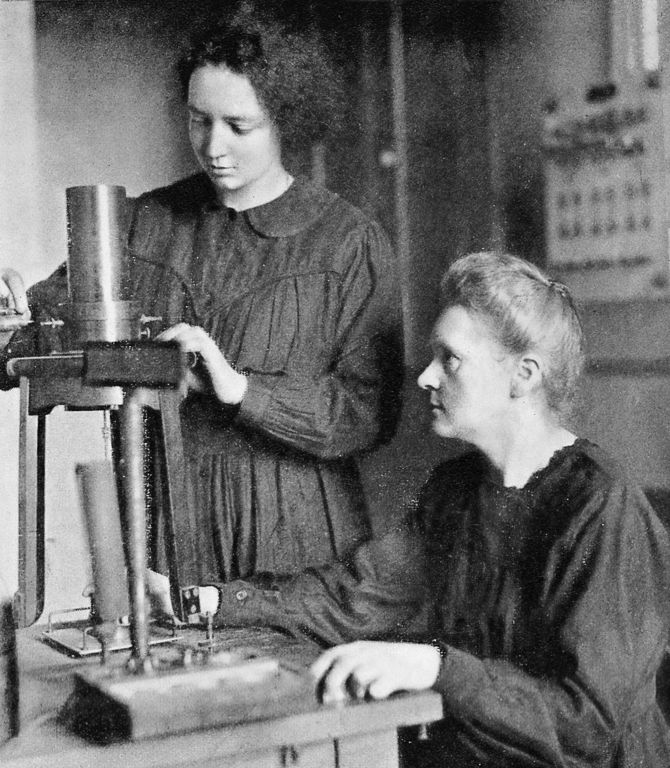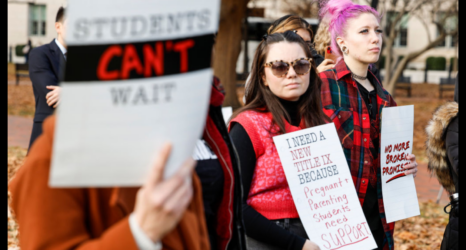I was a humanities teacher—so why couldn’t I rattle off a parallel women’s history timeline? It hit me: Like my students, I had been taught a “womanless” history.

When I was eight, my father drove our family through the streets of New Haven, pointing out Yale’s residential colleges by name. Behind ornate metal gates, I glimpsed majestic elms and sunlit gardens of the inner quadrangles.
“I’m going to college here too,” I announced.
“They don’t accept women,” he answered, listing women’s colleges. I vowed to prove him wrong—I would go.
History was with me. In 1980, I graduated with Yale’s 10th class to include women—a woman’s power symbol pinned to my robe. Like many women of my generation, I believed barriers to women were coming down.
I became an English teacher, and embraced opportunities to advocate for women’s equity throughout my career. Works by Toni Morrison, Margaret Atwood, Julia Alvarez, Chimamanda Adichie and others, immersed students in diverse, female perspectives. Class discussions drew parallels to contemporary women’s issues.
Late in my career, as I drove a group of 9th grade girls home from a school trip, they complained about sexism at school. I asked, “Wouldn’t it be great if history books had as much information about women as men?” Peals of laughter erupted. “But women didn’t do anything!” they said.
The following day, I debriefed with a colleague in the history department. “We didn’t get to women last year,” he sighed. A term paper delayed the “unit” on suffrage; “women” had been cut.
Hidden Figures Teach a “Hidden Curriculum”
This episode provoked a moment of reckoning for me as a teacher. Why couldn’t I rattle off a parallel women’s history timeline? Then it hit me. Like my students, I had been taught a “womanless” history.
I began to research how women’s history is covered in U.S. textbooks. I read “Where are the Women?: A Report on the Status of Women in United States Social Studies Standards,” commissioned by The National Women’s History Museum. After examining all 50 state standards, scholars found gender bias, underrepresentation and stereotypes permeate American textbooks.
Although women’s topics and individuals appear sporadically, textbooks marginalize women’s perspectives, historical context and achievements. In other words, they don’t teach women’s history.
Womanless History Creates Stereotype Threat
Why does this matter? Women internalize the “hidden curriculum” of patriarchal education: Boys are more capable than girls. At everything.
Myra Pollack Sadker, co-author of Still Failing at Fairness: How Gender Bias Cheats Girls and Boys in School and What We Can Do about It, wrote, “Each time a woman reads a womanless history, she learns she is worthless.”
The social psychologists Claude Steele and Joshua Aronson researched the phenomenon of stereotype threat: Studying the effect of bias in the classroom, they showed how negative stereotypes impair academic performance. When U.S. textbooks exclude positive examples of female scientists, girls learn that scientists are male. Overcoming this bias eats up mental energy, impacts performance and changes behavior.
In an American Association of University Women report, The STEM Gap: Women and Girls in Science, Technology, Engineering and Math, researchers found “girls and women are systematically tracked away from science and math throughout their educations, limiting their training and options to go into these fields as adults.” Because jobs in computer Science and Engineering are highly paid, biased instruction reinforces the gender pay gap.
Seven Ways to Recognize Gender Bias
Still Failing at Fairness distills years of research into an eye-opening list: “A Baker’s Half Dozen: Seven Forms of Bias in Curriculum Materials.” The authors recommend teachers and students examine textbooks for the following forms of bias. Their exercise helped me discover extraordinary “hidden figures” in women’s history.
1. Invisibility: What You Don’t See Makes a Lasting Impression
Numerous studies emphasize the need for positive role models for women, especially in science and technology. Though some progress has been made, the majority of U.S. school children still draw a man when asked to draw a scientist.
(Take the quiz at the end of this article to put a new face on the profession!)
2. Stereotyping
When Marie Curie accepted the shared 1903 Nobel Prize in Physics, the president of the Swedish Academy quoted Genesis, saying: “It is not good that the man should be alone; I will make a help-mate for him.” Domestic stereotypes like these diminish women.

3. Imbalance and Selectivity: A Tale Half-Told
When textbooks hyper-focus on the male face of a given movement, powerful women disappear. Chicano Civil Rights leader, Dolores Huerta, was one of the most influential labor activists of the 20th century. Significantly, she is not as well-known as Cesar Chavez—though they co-founded the United Farm Workers Association.
4. Unreality: Rose-Colored Glasses
Many U.S. texts lack a comprehensive timeline of the laws and acts that repressed women. Denied property rights, patents for their inventions, the right to divorce or keep custody of their children, women were blocked from higher education for hundreds of years. Without this history, women internalize, rather than challenge, the ongoing inequity of their legal status.
5. Fragmentation and Isolation
Women’s History Month gets a ninth of the year’s attention. An insert of “Ten women scientists,” removes them from a text’s “main” narrative. For historical context, students can create Women’s History timelines, drawing from NWHM’s lesson, Unsung Voices: Black Women and their Role in Women’s Suffrage, or Nora S. Jones’s text, Vanguard: How Black Women Broke Barriers, Won the Vote, and Insisted on Equality for All.
6. Linguistic Bias
Gendered pronouns like “mankind,” “forefathers” and “businessmen” imprint male superiority.
Similarly, when a text says women were “given” the right to vote, it awards agency to men. On the road to suffrage, women protested and went to jail, some enduring torture. No one “gave” them anything.
7. Cosmetic Bias: Shiny Covers
In one widely-used history textbook, a tiny, period portrait of Elizabeth I is dwarfed by a glossy insert of Cate Blanchett, with a lengthy discussion about the monarch’s virginity; Elizabeth I is not credited for transforming a weakened Britain into the foremost naval power in Europe.
Claiming Women’s History: The Way Forward
At present, U.S. textbooks reinforce the power dynamics of a male dominated society.
In the immediate future, superb online lessons in women’s history can be found at PBS Learning and The National Women’s History Museum. At their joint symposium, UnLadylike 2020, educators and historians agreed that infusing existing curriculum with online resources like these can help students learn about women’s history now. Scholars and educators at the conference encouraged parents, teachers and students to advocate for curricular equity.
In an encouraging sign, parents in Hawaii recently rejected online lessons for racist and sexist content. We all need to do the same.
Test Your Knowledge of Women’s History: Can You Name the Scientist?
These women transformed our understanding of the universe. It’s time we learn their names.
In each question, click the link to discover a “Hidden Figure.” Together, they reveal an inspiring archetype: the female scientist.
- Who proved the existence of dark matter? (Read here for the answer.)
- Who discovered the nuclear shell of atomic particles? (Read here for the answer.)
- Whose research formed the basis of wifi, CDMA and bluetooth wireless technology? (Read here for the answer.)
- Who first observed the double helix of DNA? (Read here for the answer.)
- What scientist discovered the complex social structure of primates? (Read here for the answer.)
- Who discovered how the body stores and utilizes energy? (Read here for the answer.)
- Whose research established the Higgs Boson particle? (Read here for the answer.)
- Whose work catalyzed environmental science? (Read here for the answer.)
- Who discovered the elements, radium and polonium? (Read here for the answer.)
- Who discovered nuclear fission? (Read here for the answer.)
Up next:





